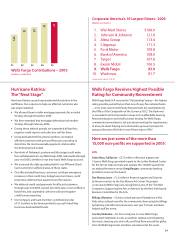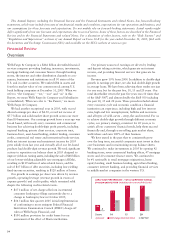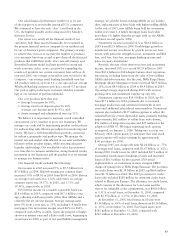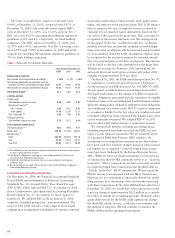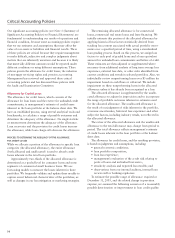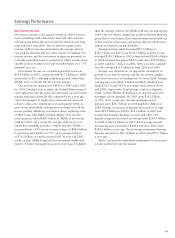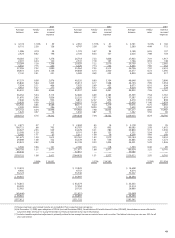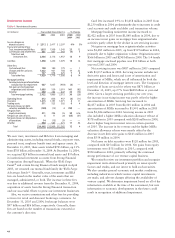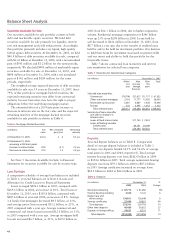Wells Fargo 2005 Annual Report Download - page 40
Download and view the complete annual report
Please find page 40 of the 2005 Wells Fargo annual report below. You can navigate through the pages in the report by either clicking on the pages listed below, or by using the keyword search tool below to find specific information within the annual report.
38
Critical Accounting Policies
Our significant accounting policies (see Note 1 (Summary of
Significant Accounting Policies) to Financial Statements) are
fundamental to understanding our results of operations and
financial condition, because some accounting policies require
that we use estimates and assumptions that may affect the
value of our assets or liabilities and financial results. Three
of these policies are critical because they require management
to make difficult, subjective and complex judgments about
matters that are inherently uncertain and because it is likely
that materially different amounts would be reported under
different conditions or using different assumptions. These
policies govern the allowance for credit losses, the valuation
of mortgage servicing rights and pension accounting.
Management has reviewed and approved these critical
accounting policies and has discussed these policies with
the Audit and Examination Committee.
Allowance for Credit Losses
The allowance for credit losses, which consists of the
allowance for loan losses and the reserve for unfunded credit
commitments, is management’s estimate of credit losses
inherent in the loan portfolio at the balance sheet date. We
have an established process, using several analytical tools and
benchmarks, to calculate a range of possible outcomes and
determine the adequacy of the allowance. No single statistic
or measurement determines the adequacy of the allowance.
Loan recoveries and the provision for credit losses increase
the allowance, while loan charge-offs decrease the allowance.
PROCESS TO DETERMINE THE ADEQUACY OF THE ALLOWANCE
FOR CREDIT LOSSES
While we allocate a portion of the allowance to specific loan
categories (the allocated allowance), the entire allowance
(both allocated and unallocated) is used to absorb credit
losses inherent in the total loan portfolio.
Approximately two-thirds of the allocated allowance is
determined at a pooled level for consumer loans and some
segments of commercial small business loans. We use
forecasting models to measure the losses inherent in these
portfolios. We frequently validate and update these models to
capture recent behavioral characteristics of the portfolios, as
well as changes in our loss mitigation or marketing strategies.
The remaining allocated allowance is for commercial
loans, commercial real estate loans and lease financing. We
initially estimate this portion of the allocated allowance by
applying historical loss factors statistically derived from
tracking loss content associated with actual portfolio move-
ments over a specified period of time, using a standardized
loan grading process. Based on this process, we assign loss
factors to each pool of graded loans and a loan equivalent
amount for unfunded loan commitments and letters of credit.
These estimates are then adjusted or supplemented where
necessary from additional analysis of long term average loss
experience, external loss data, or other risks identified from
current conditions and trends in selected portfolios. Also, we
individually review nonperforming loans over $3 million for
impairment based on cash flows or collateral. We include
impairment on these nonperforming loans in the allocated
allowance unless it has already been recognized as a loss.
The allocated allowance is supplemented by the unallo-
cated allowance to adjust for imprecision and to incorporate
the range of probable outcomes inherent in estimates used
for the allocated allowance. The unallocated allowance is
the result of our judgment of risks inherent in the portfolio,
economic uncertainties, historical loss experience and other
subjective factors, including industry trends, not reflected in
the allocated allowance.
The ratios of the allocated allowance and the unallocated
allowance to the total allowance may change from period to
period. The total allowance reflects management’s estimate
of credit losses inherent in the loan portfolio at the balance
sheet date.
The allowance for credit losses, and the resulting provision,
is based on judgments and assumptions, including:
• general economic conditions;
• loan portfolio composition;
• loan loss experience;
• management’s evaluation of the credit risk relating to
pools of loans and individual borrowers;
• sensitivity analysis and expected loss models; and
• observations from our internal auditors, internal loan
review staff or banking regulators.
To estimate the possible range of allowance required at
December 31, 2005, and the related change in provision
expense, we assumed the following scenarios of a reasonably
possible deterioration or improvement in loan credit quality.



